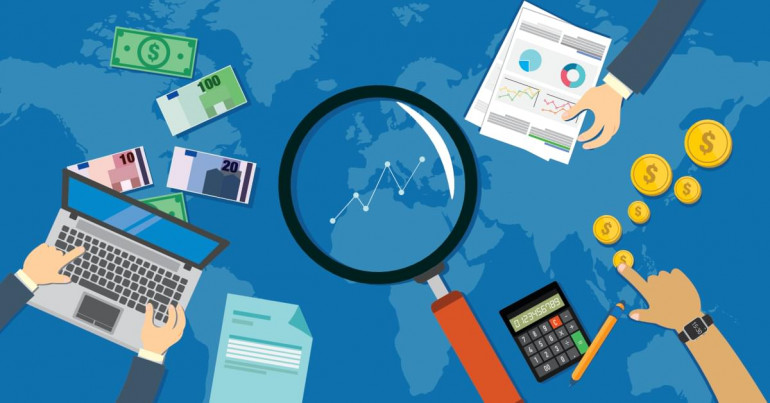
The foreign exchange markets are volatile and in near-constant movement. Demand for a particular currency causes an increase in buying or selling, which consequently impacts the exchange rate. But what causes this demand to rise or fall? One of the most important elements is investor sentiment around a given country or currency zone’s economic performance – and this means that economic indicators are closely monitored. Let’s take a closer look.

Why do the markets monitor economic performance?
For those dealing with the live currency markets, such as investors, they’re trying to predict which currencies will increase or decrease in value. Now, we don’t advise that for anyone making a big purchase – your hedging strategy is crucial to protecting your budget – but for those who do, how a country’s economy is performing is often a key factor in demand for a currency.
This means many will monitor both the economic indicators themselves and the forecast numbers in advance, either to get a head march or because numbers coming in above or below forecasts can have a strong impact on the markets.
However, even then, there isn’t certainty. Sometimes even an exceptional economic result will yield little reaction. In this case, it’s usually said to have been “priced in”, in that the markets were expecting it to happen and have already reacted. In other cases, there might be other news going on, such as politically, which is taking precedence in investor sentiment.
What are the major economic indicators in the FX markets?
While there are numerous economic releases, among the most important are the following six:
1. Purchasing Managers’ Index (PMI)
Purchasing Managers’ Indices, normally known as PMI, are monthly releases of the results from surveys of major business executives in key areas. Normally named for the organisations that run them – the Institute for Supply Management (ISM), Singapore Institute of Purchasing and Materials Management (SIPMM) and S&P Global, formerly IHS Markit – they cover performance in key areas like new orders, inventories, production, supplier deliveries and staffing in industries like manufacturing and services. The results are given quantitatively, with 50 indicating no change, 100 indicating total positive change, and 0 indicating total negative change.
2. Non-farm payrolls
Non-farm payrolls are an influential economic indicator that measures the number of workers in the workforce apart from those in the agricultural industry, the military, private households, non-profits and company owners. By and large, traders pay most attention to the numbers out of the US, where the Department of Labor releases figures from 670,000 worksites every month. The UK equivalent is sometimes known as HMRC payroll changes.
This is a key economic measurement because it gives a strong insight into the health of the economy – if employment shrinks, then it’s a sign that businesses are less confident about the future. If it increases, then it’s a sign that businesses consider it worth investing in growth.
3. Balance of payments and trade
This is another important way to get a high-level overview of a country’s performance. Balance of payments represents the totality of a country’s international economic transactions, including imports and exports, as well as financial capital and financial transfers.
Within balance of payments, we find balance of trade, which specifically shows a country’s imports and exports. If a country exports more than it imports, then it’s said to be in a surplus, which can sometimes have a positive impact on the markets. If it imports more than it exports, it’s said to be in a deficit, which can sometimes have a negative impact.
However, it’s important to remember that trade balances are often priced in – at the time of writing, about 66 countries have a surplus, while the rest all have a deficit. Movement is more likely to come when figures over- or underperform against expectations, or consistently show an increasing or decreasing trend.
4. GDP figures
There are a number of GDP releases throughout the year, of which GDP growth is the most important. GDP, or gross domestic product, is an indicator of the total gross value that all relevant producers have added to an economy.
GDP growth, which often makes national headlines, shows whether that gross value is expanding or contracting. A contraction points to a likely negative outlook for an economy. However, as this is a major economic indicator and other indicators may already point towards a contraction, a negative reading can sometimes be priced in.
We also see other figures, such as GDP per capita, which shows economic output per person as an indicator of a standard of living.
5. Consumer confidence
In addition to business-side figures, consumer sentiment is also an important economic indicator for the markets. Among the most important figures in this field are the results of the Consumer Confidence Index (CCI), which is carried out on a monthly basis by Nielsen and measures American consumers’ spending plans for large purchases like real estate and cars.
Respondents are asked about their opinion of the current business and employment conditions and about their expectations around business, employment and their own household’s income in six months’ time.
Again, if the figures are positive, it’s a sign the economy is doing well, and purchases may increase – or the converse if negative.
6. Inflation rate
It’s one we’re all familiar with in 2023, but inflation has long been one of the key economic indicators for the markets. This usually relies on each country’s Consumer Price Index (CPI), which measures a basket of goods and services that is considered representative of aggregate consumer spend, and on the Wholesale Price Index (WPI) or Producer Price Index (PPI), which measures prices charged by manufacturers and wholesalers.
Inflation not only gives an idea of how an economy is performing, but also allows for some form of prediction – unreliable though it may sometimes be – into what sort of fiscal measures we might expect from a central bank.

Protecting your budget against volatility
This is just a snapshot of the many economic indicators that can impact the market on a regular basis. However, as we’ve seen, their impact isn’t entirely predictable – sometimes the markets will react strongly, other times only slightly, and sometimes even big news will be priced in.
The best way to secure your money is to put in place a hedging strategy that will safeguard it against the markets. In the meantime, ensure you keep up to date by subscribing to our daily and weekly market news.
Alexander Fordham
Alexander is a writer specialising in foreign exchange and finance for companies with cross-border exposure. He’s written on topics including currency risk, international taxation and global employment for seven years. You can find him out hiking, travelling and working from Spain in the sunnier months.



